Safe bike path in Alsergrund: Children in danger - measures required!

Safe bike path in Alsergrund: Children in danger - measures required!
in Fuchsthallergasse, directly in front of the newly opened clinic, there are serious concerns about the safety of cyclists, especially children. The cycle path, which was built as part of a comprehensive Viennese cycle path, could prove to be risky. The ÖVP has prompted the awareness of the problems to contribute an application for temporal control and increased child safety in the district council, which was fortunately accepted. Despite these steps, the situation remains tense.
The clinic manager Dr. Nicole Grois, pediatrician, has been calling for measures to improve traffic safety for over a year, such as a protective grille to the street and speed reducing measures. Since the clinic opened a month ago, concerns about fast cyclists at the gates of the clinic have strengthened. Dr. Grois has repeatedly contacted MA 46, the responsible transport organ, but there have been specific measures so far. The MA 46 emphasizes that traffic safety, especially that of children, has a high priority, but believes that the situation must be observed further.
Expansion of the wheel infrastructure
On July 1, 2025, the construction of a facility cycle path in Fuchsthallergasse began, which runs from Währinger belt to Lustkandlgasse. This work is part of the comprehensive bike path expansion plans of the city of Vienna, which rely on over 250 projects and almost 100 km of cycle path network. The construction is expected to be completed on August 31, 2025, while at the same time, sidewalks to improve traffic safety on the adjacent side streets. The existing traffic chaos is regulated during the construction work by diversions via the Währinger belt and Achamergasse.
The district manager Saya Ahmad (SPÖ) has been in contact with Dr. Grois and checks the possibility of reducing speed. Ahmad is aware of the risks that bring speed transitions for cyclists and considers consciousness -forming measures such as soil markings make sense. A safer design of the wheel infrastructure is urgently necessary to ensure the safety of all road users.
trends in cycling
According to a new guideline for cycling in Austria, comprehensive changes in the planning and design of cycle paths are required. These include wider cycling systems, the clear separation of cycling and car traffic at higher speeds. The need for action becomes clear based on accident statistics: Between 2012 and 2020, the number of cyclists who had crashed rose by 42 percent. These developments make it clear that the cycling infrastructure must be adapted to the increased requirements.
The Viennese cycle path offensive tries to take this development into account. The proportion of cycle paths in all traffic rose to 11 percent by 2024, while in 2019 it was only 7 percent. Innovative approaches, such as the introduction of quick cycle connections, are part of the plan to make the cycling infrastructure more attractive and safer.
The current situation in Fuchsthallergasse is not only a local problem, but also reflects broader challenges with which bicycle traffic is confronted in Austria. Residents and road users hope for soon improvements to ensure safe cooperation on the streets.
| Details | |
|---|---|
| Ort | Fuchsthallergasse, 1090 Wien, Österreich |
| Quellen | |
